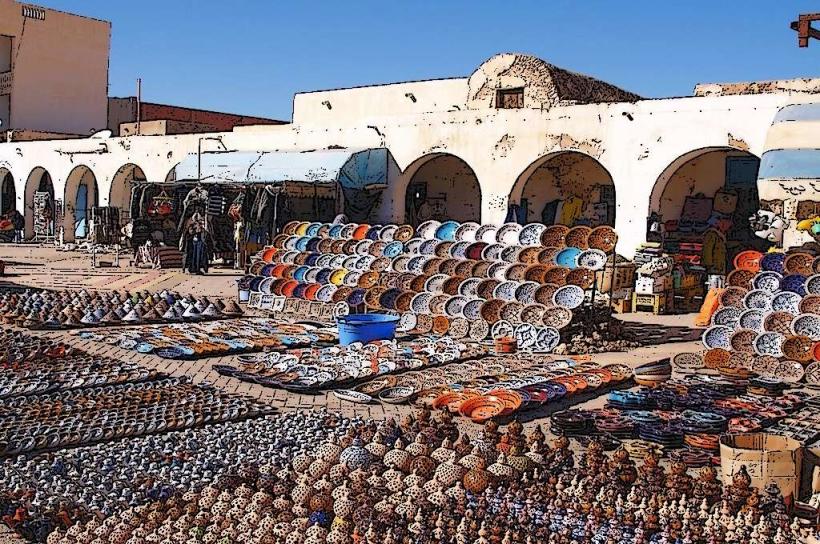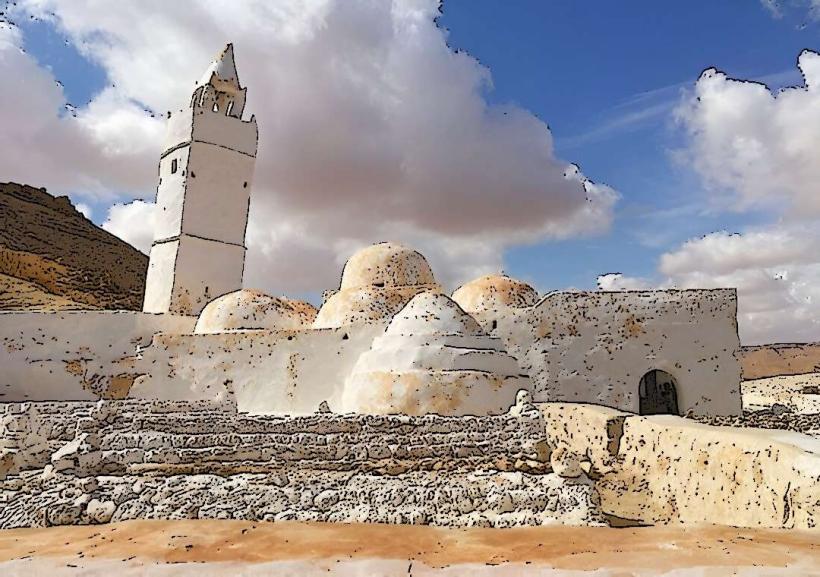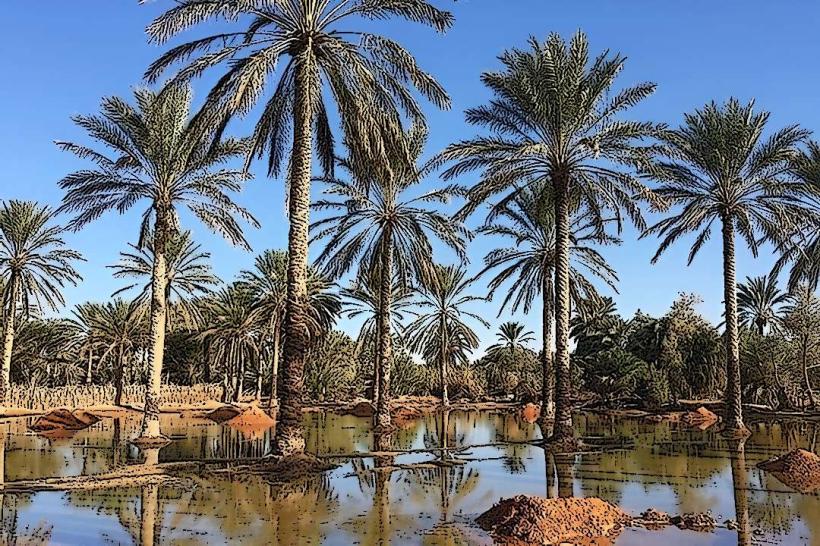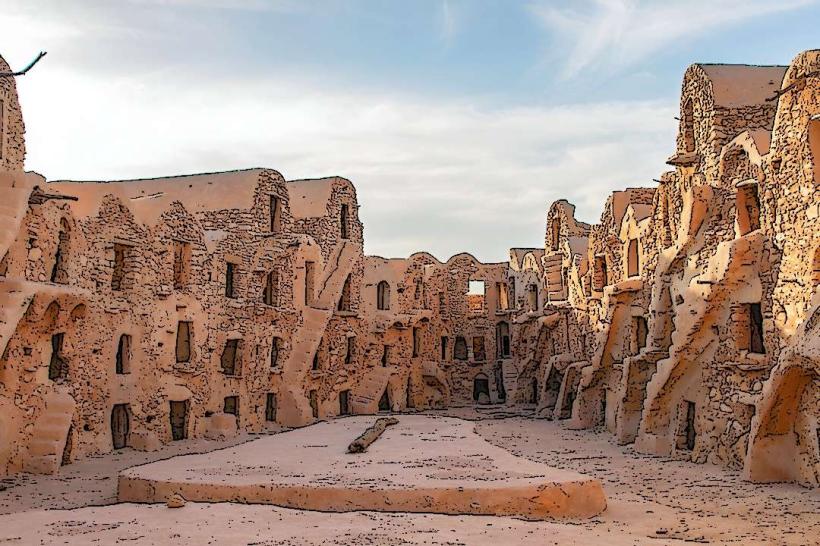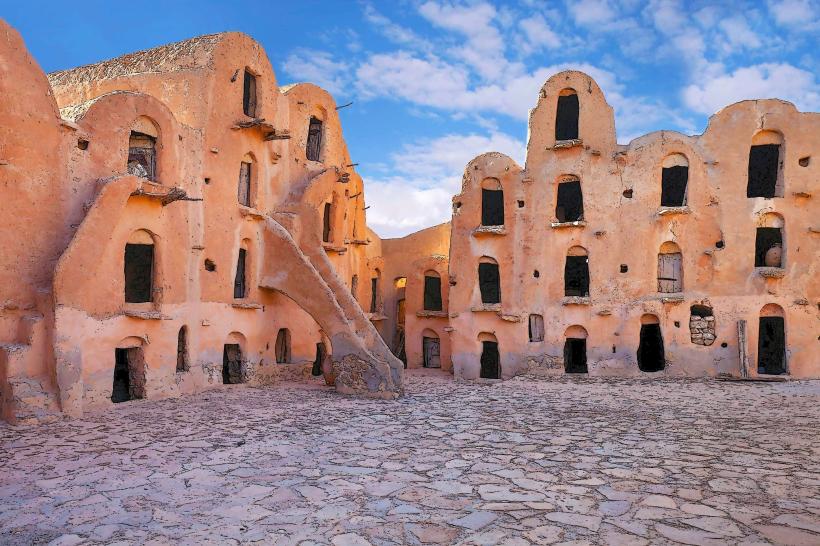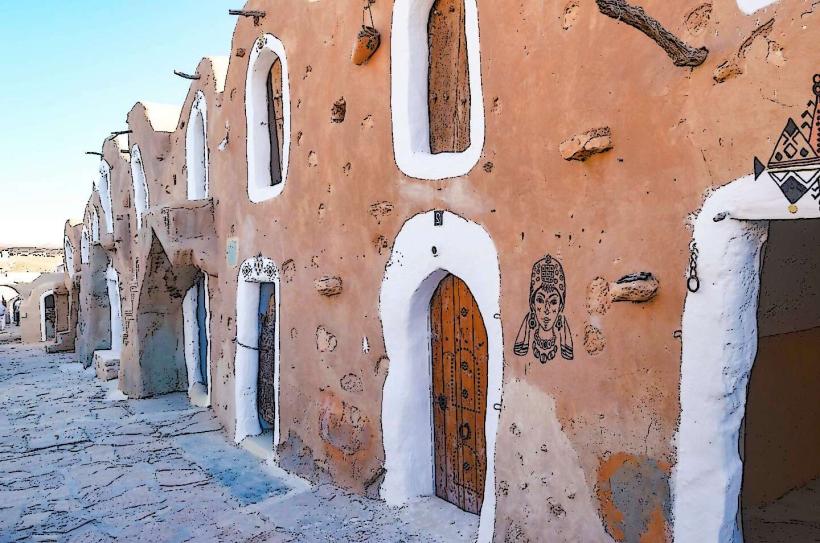Information
City: TataouineCountry: Tunisia
Continent: Africa
Tataouine, Tunisia, Africa
Overview
Tataouine is a historic town in southern Tunisia, tucked deep into the dry, sun-baked land near the Libyan border, equally important it’s the capital of Tataouine Governorate, the biggest and one of the emptiest stretches in the country, where miles of sun-baked land roll out in every direction, to some extent Tataouine is famous for its ancient Berber ksour-fortified granaries with sunbaked walls-its striking desert architecture, and its deep cultural roots, meanwhile it also became known worldwide after lending its name to the dusty, twin-sunned planet Tatooine in Star Wars.Tataouine sits roughly 530 kilometers south of Tunis, about 140 kilometers past Medenine, with the Libyan border just a short drive away, besides the terrain is rugged and semi-arid, with stark mountains, wind-scoured plateaus, and deep valleys where ancient Berber villages cling to the cliffs and hillside rock.The region has a boiling desert climate, like the Sahara-scorching summers that can bake the ground, mild winters, and barely a drop of rain all year, simultaneously in the dry months, sandstorms sweep through often, the air turning gritty against your skin.For centuries, Amazigh (Berber) tribes like the Ksourians have called Tataouine home, building distinctive fortified villages-ksour-where sacks of grain were kept reliable from raiders, not only that islamic Period: As the Islamic world expanded, the region stayed fairly remote, yet camel caravans still carried its goods and ideas along trade routes tied to faith and commerce.Colonial and Modern Era: During French rule, soldiers set up a miniature military outpost in Tataouine, its walls baking under the desert sun, besides after Tunisia gained independence, it grew into the south’s hub for government and culture, where the scent of fresh paper lingered in crowded offices.Urban and rural Ksour-fortified, multi‑level granaries-were built by Berber tribes to guard their food and treasures, their thick walls holding the cool scent of stored grain, and built from mudbrick, stone, and timber, they hold compact ghorfas-cool, dim storage rooms-clustered around a central courtyard.Not far from Tataouine, you’ll find well-known spots like Ksar Ouled Soltane, Ksar Hadada, and the cliffside village of Chenini, in turn troglodyte and cliff villages dot the hills, their homes carved deep into rock or stacked from the rough, sun-warmed stones nearby.The structures seem to dissolve into the hills, their weathered stone matching the earth’s muted browns, not only that tataouine’s layout blends the fresh with the vintage-broad streets lined with government offices, schools, and busy markets, yet still dotted with sandstone arches and shaded courtyards that echo its traditional style.Agriculture in the region is restricted by dry, sun-baked soil and scarce rainfall, on top of that they grow olives, barley, and dates, along with a few hardy dryland vegetables, mostly in the shaded wadis and scattered oases.As it turns out, Pastoralism is still a way of life in the surrounding regions, where nomadic and semi‑nomadic families tend herds of goats, sheep, and camels under the open sky, along with in rural villages, people still weave dazzling textiles, shape clay into pottery, and craft silver jewelry, some of which ends up in the hands of curious tourists.Oil and gas have drawn fresh attention in recent years, as parts of the governorate have lured investors searching for hydrocarbons deep beneath its dusty plains, to boot tourism is booming, fueled by fascination with Berber traditions, the sunbaked ksour, sweeping desert horizons, and the allure of film locations.The community is mostly Amazigh (Berber), with traditions and language still woven deeply into family life, especially in modest mountain villages, not only that arabic is the official language, yet you’ll often hear Tamazight-Berber dialects-spoken around kitchen tables and in bustling neighborhood streets.Islam is the dominant faith, shaped at times by Sufi traditions and the rhythms of local customs, like the soft beat of a drum in a village square, in turn community life thrives on close bonds and warm hospitality, especially in rural ksour, where extended families still gather under one roof and share long meals together, not entirely Food and Traditions: Meals are simple yet hearty-think couscous with dried meat and chickpeas, lamb stew scented with desert herbs, the green, earthy mloukhiya, warm flatbreads, and sticky date sweets, likewise traditional Berber clothing still survives among older generations, with loose robes, colorful head wraps like chechias or turbans, and belts woven by hand.Festivals often spring from local harvests, sacred dates, and age-heritage songs and poetry, with the lively beat of Mezwed echoing through the streets, and infrastructure and development in education include several primary and secondary schools, along with technical institutes where the scent of chalk still hangs in the air, slightly The governorate is working to open up remote areas, laying down roads where dust still hangs in the air, moreover healthcare in Tataouine relies on a regional hospital in the city and a handful of satellite clinics, yet reaching care in the distant desert villages is still hard.Transport’s easy-well-kept roads link it straight to Medenine and Gabès, smooth enough you can hear your tires hum, as a result louages, the shared taxis often packed with chatter and the smell of warm bread, are the go-to way to discover between cities.Tataouine doesn’t have its own airport, so you’ll need to fly into Djerba–Zarzis International, about a few hours away past sun-baked roads, in conjunction with chenini, a striking Berber village tucked into a steep mountainside, holds weathered stone granaries and a community that still hums with daily life.You’ll perceive sweeping desert valleys and catch glimpses of traditions still alive, like the sound of drums echoing at sunset, what’s more douiret is another troglodyte village, known for its blend of sacred sites and rich cultural heritage, where sunlit stone doorways open into cool, shadowed rooms.Ksar Ouled Soltane-arguably the most famous ksar-served as a striking backdrop in *Star Wars: The Phantom Menace*, its sun-baked walls glowing like copper under the desert sky, and ksar Hadada is well known for its striking architecture, and you might recognize its sunbaked walls from scenes in the Star Wars films.In a way, Resilient and proud, Tataouine stands in Tunisia’s deep south-long overlooked, yet alive with indigenous traditions and a quiet, self-sufficient spirit, like the scent of fresh bread baking in a clay oven, as well as cultural depth runs through the region, rooted in its Berber ancestry, with traditions alive in the warm aroma of spiced tagines, the curved lines of earthen homes, the language, and everyday customs.Remote, yet connected-Tataouine may feel isolated at times, but it’s steadily linking into national and global networks through tourism, media, and economic projects, from bustling market tours to online cultural showcases, also tataouine isn’t just a name lifted from science fiction-it’s a living emblem of Berber resilience, desert-born ingenuity, and the deep, sun-baked culture of southern Tunisia, maybe With its bold architecture, timeworn villages, and raw, wind‑carved landscapes, it offers a vivid glimpse into one of North Africa’s most authentic regions.
Author: Tourist Landmarks
Date: 2025-10-29
Landmarks in tataouine

